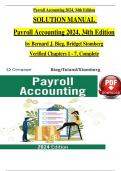Examen
Solution Manual for Payroll Accounting 2024, 34th Edition by Bernard J. Bieg, Bridget Stomberg, Verified Chapters 1 - 7, Complete Newest Version
- Cours
- Établissement
- Book
Solution Manual for Payroll Accounting 2024, 34th Edition by Bernard J. Bieg, Bridget Stomberg, Verified Chapters 1 - 7, Complete Newest Version Solution Manual for Payroll Accounting 2024, 34th Edition by Bernard J. Bieg, Bridget Stomberg, Verified Chapters 1 - 7, Complete Newest Version Sol...
[Montrer plus]



